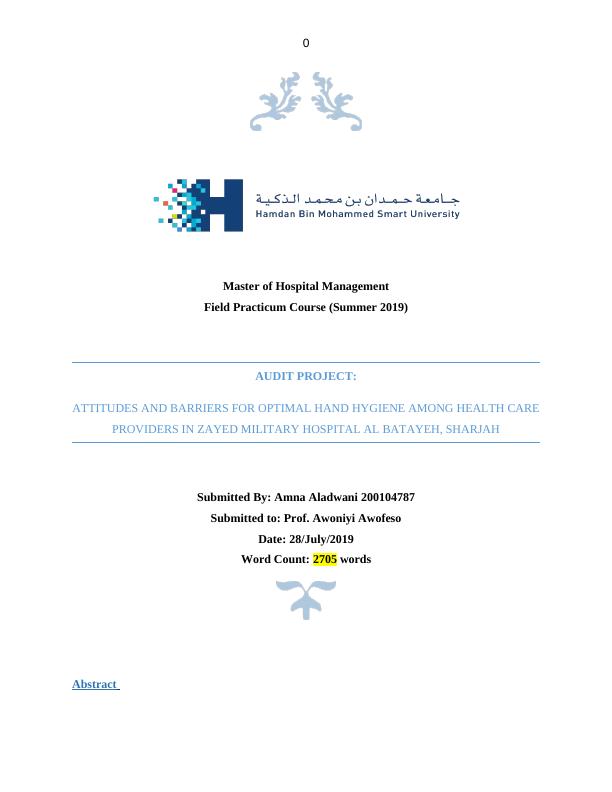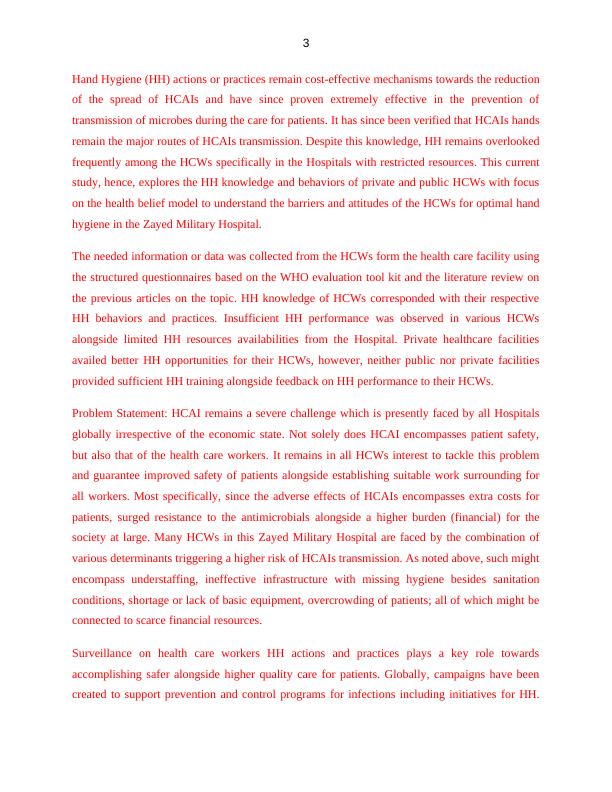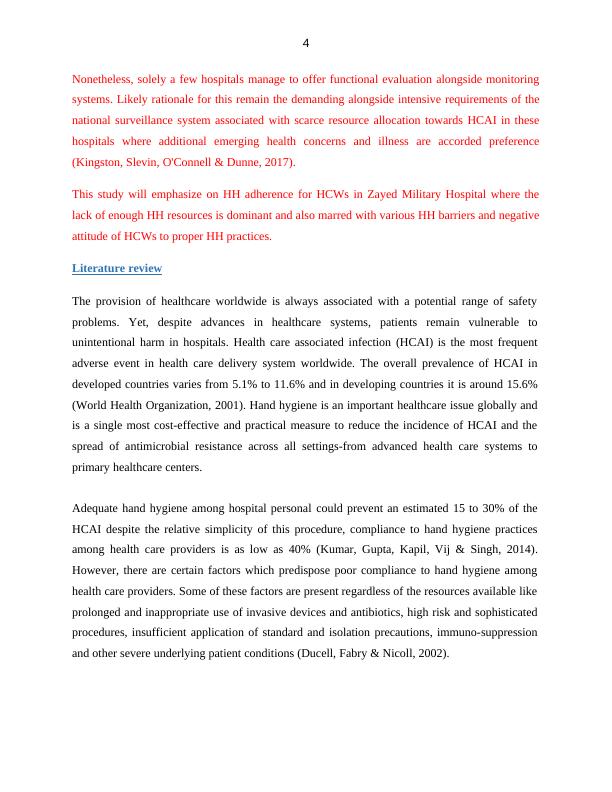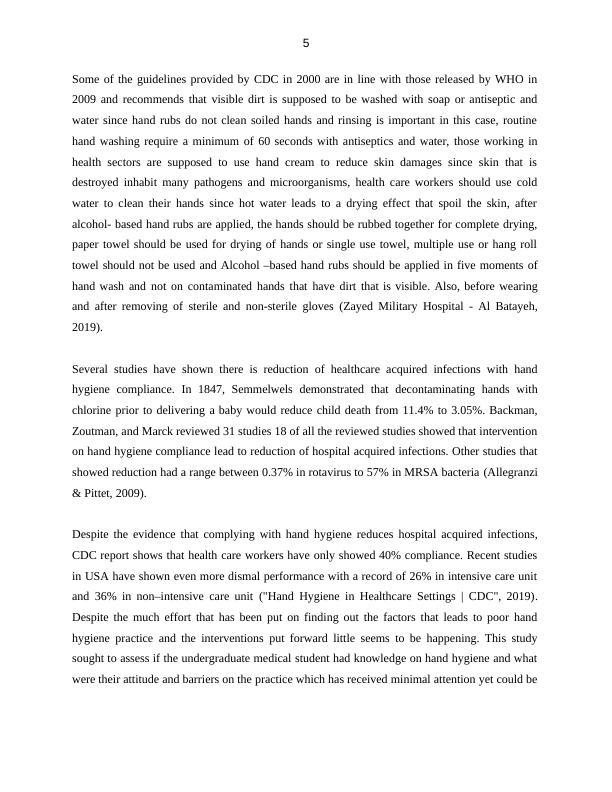Master of Hospital Management Field Practicum Course: ATTITUDES AND BARRIERS FOR OPTIMAL HAND HYGIENE AMONG HEALTH CARE PROVIDERS in ZAYED MILITARY hospital AL BATAYEH, SHARJAH
Added on 2022-10-14
22 Pages7086 Words339 Views
0
Master of Hospital Management
Field Practicum Course (Summer 2019)
AUDIT PROJECT:
ATTITUDES AND BARRIERS FOR OPTIMAL HAND HYGIENE AMONG HEALTH CARE
PROVIDERS IN ZAYED MILITARY HOSPITAL AL BATAYEH, SHARJAH
Submitted By: Amna Aladwani 200104787
Submitted to: Prof. Awoniyi Awofeso
Date: 28/July/2019
Word Count: 2705 words
Abstract
Master of Hospital Management
Field Practicum Course (Summer 2019)
AUDIT PROJECT:
ATTITUDES AND BARRIERS FOR OPTIMAL HAND HYGIENE AMONG HEALTH CARE
PROVIDERS IN ZAYED MILITARY HOSPITAL AL BATAYEH, SHARJAH
Submitted By: Amna Aladwani 200104787
Submitted to: Prof. Awoniyi Awofeso
Date: 28/July/2019
Word Count: 2705 words
Abstract

1
Introduction: “Prevention is better than cure”. Therefore, proper hands hygiene practice stands
out to be one of the measures of reducing transmission of disease to patients and to health care
providers. The practice is considered to be in the front line in prevention of health care
associated infections (HCAI) and Nosocomial Infections/Hospital Acquired Infections (Kumar,
Gupta, Kapil, Vij & Singh, 2014). Washing hands is taking a second position from hand rub to
meet the recommended standards with optimum time considered to be between 30 seconds and
one minute. The alcohol antiseptics are recommended worldwide due to their broad-spectrum
antimicrobial effects, the application process is easy and they are tolerable to many people skins
(Zayed Military Hospital - Al Batayeh, 2016). The scope of hand hygiene includes hand
washing, use of antiseptics to wash hands or rub and surgical hand antisepsis. Health care
associated infection (HCAI) is one of the most significant, and current phenomena for
discussions in health care industry. Hand hygiene was thought to be a key factor in reducing
hospital acquired infection during the initial development of healthcare system (Ducell, Fabry &
Nicoll, 2002). The present study aimed to determine hand hygiene compliance, attitude and
barriers among health care workers (HCWs).
Material & Methods: A cross sectional observational survey was conducted in 100 health care
providers from different out-patient departments at Zayed Military Hospital Al Batayeh,
Sharjah Convenience consecutive sampling technique was used to enroll HCPs. Modified hand
hygiene checklist, interview for identification of barriers was used to ascertain compliance,
attitude and barriers. Appropriate descriptive statistics was applied to compute the results.
Results: Results shows higher adherence (10%) to hand hygiene practices among faculty
followed by consultants (7.14%) and specialists (6.71%). However, the partial adherence to
hand hygiene practices was surprisingly high (63.04%) among HCWs. There was significant
difference in attitude towards hand hygiene practices among medical and nursing professionals.
Further, findings revealed that inconvenient placement of hand hygiene facility was prime
reported (85.21%) barrier for poor adherence to hand hygiene practices followed by over
burden of patient (80.87%), understaffing/overcrowding (81.73%) and hand hygiene is time
consuming activity (80.86%) HCWs.
Introduction: “Prevention is better than cure”. Therefore, proper hands hygiene practice stands
out to be one of the measures of reducing transmission of disease to patients and to health care
providers. The practice is considered to be in the front line in prevention of health care
associated infections (HCAI) and Nosocomial Infections/Hospital Acquired Infections (Kumar,
Gupta, Kapil, Vij & Singh, 2014). Washing hands is taking a second position from hand rub to
meet the recommended standards with optimum time considered to be between 30 seconds and
one minute. The alcohol antiseptics are recommended worldwide due to their broad-spectrum
antimicrobial effects, the application process is easy and they are tolerable to many people skins
(Zayed Military Hospital - Al Batayeh, 2016). The scope of hand hygiene includes hand
washing, use of antiseptics to wash hands or rub and surgical hand antisepsis. Health care
associated infection (HCAI) is one of the most significant, and current phenomena for
discussions in health care industry. Hand hygiene was thought to be a key factor in reducing
hospital acquired infection during the initial development of healthcare system (Ducell, Fabry &
Nicoll, 2002). The present study aimed to determine hand hygiene compliance, attitude and
barriers among health care workers (HCWs).
Material & Methods: A cross sectional observational survey was conducted in 100 health care
providers from different out-patient departments at Zayed Military Hospital Al Batayeh,
Sharjah Convenience consecutive sampling technique was used to enroll HCPs. Modified hand
hygiene checklist, interview for identification of barriers was used to ascertain compliance,
attitude and barriers. Appropriate descriptive statistics was applied to compute the results.
Results: Results shows higher adherence (10%) to hand hygiene practices among faculty
followed by consultants (7.14%) and specialists (6.71%). However, the partial adherence to
hand hygiene practices was surprisingly high (63.04%) among HCWs. There was significant
difference in attitude towards hand hygiene practices among medical and nursing professionals.
Further, findings revealed that inconvenient placement of hand hygiene facility was prime
reported (85.21%) barrier for poor adherence to hand hygiene practices followed by over
burden of patient (80.87%), understaffing/overcrowding (81.73%) and hand hygiene is time
consuming activity (80.86%) HCWs.

2
Conclusion & recommendation: The study concluded poor hand hygiene compliance among
HCWs. Study findings recommend improvement in existing facilities for hand hygiene and
make them readily accessible for HCWs at their respective departments to enable them to
engage in good practices which will be beneficial for them and patients.
Introduction
The Health Care Associated Infections (HCAI) trigger the main challenges to the health care
provision. This is because of the burden put on the people, families as well as health services.
HCAI is described as the infection acquired by both patients and healthcare providers while
seeking and providing treatment in the healthcare facilities respectively. HCAIs are caused by a
range of microbes like parasites, fungi, viruses and remains readily associated with bacteria. The
routes for transmission include via endogenous or exogenous infection agents. The former agents
are the infections triggered by microorganisms present in the body of patients that spread from
one to another area often via the hands of the HCWs by touching the area infected. The latter
agents sources further act as the reservoir of infections and encompass nose, skin, mouth, vagina
and gastrointestinal tract (Kurtz, 2017).
HCWs with poor HH adherence who never wash their hands in between indirect or direct with
patients might rapidly transmit potential antimicrobial resistant bacteria to the rest of the patients.
HCWs hands slowly get exposed as well as colonized by the germs and feasibly microbes as they
tend to patients. Thus, there is a surged risk of HCAI acquisition from the HCW with augmented
amount of hand contamination specifically in the Hospital lacking HH (Schwartz, Schmitz,
Safdar & Pop-Vicas, 2018).
Exogenous infections get spread because of external sources often through direct contact with
infected patients or via the surrounding. Exogenous infections sources include HCWs, patient
care equipment, visitors, as well as medical devices. Thus, HCWs hands alongside patients
remain the major trigger for HCAI spread both exogenously and endogenously to fellow patients
and HCW and visitors. It is, thus, imperative to examine the HH behavior of health care workers
in the Hospital faced with the provision of quality health care as well as patient safety
irrespective of scarce health system facilities or systems.
Conclusion & recommendation: The study concluded poor hand hygiene compliance among
HCWs. Study findings recommend improvement in existing facilities for hand hygiene and
make them readily accessible for HCWs at their respective departments to enable them to
engage in good practices which will be beneficial for them and patients.
Introduction
The Health Care Associated Infections (HCAI) trigger the main challenges to the health care
provision. This is because of the burden put on the people, families as well as health services.
HCAI is described as the infection acquired by both patients and healthcare providers while
seeking and providing treatment in the healthcare facilities respectively. HCAIs are caused by a
range of microbes like parasites, fungi, viruses and remains readily associated with bacteria. The
routes for transmission include via endogenous or exogenous infection agents. The former agents
are the infections triggered by microorganisms present in the body of patients that spread from
one to another area often via the hands of the HCWs by touching the area infected. The latter
agents sources further act as the reservoir of infections and encompass nose, skin, mouth, vagina
and gastrointestinal tract (Kurtz, 2017).
HCWs with poor HH adherence who never wash their hands in between indirect or direct with
patients might rapidly transmit potential antimicrobial resistant bacteria to the rest of the patients.
HCWs hands slowly get exposed as well as colonized by the germs and feasibly microbes as they
tend to patients. Thus, there is a surged risk of HCAI acquisition from the HCW with augmented
amount of hand contamination specifically in the Hospital lacking HH (Schwartz, Schmitz,
Safdar & Pop-Vicas, 2018).
Exogenous infections get spread because of external sources often through direct contact with
infected patients or via the surrounding. Exogenous infections sources include HCWs, patient
care equipment, visitors, as well as medical devices. Thus, HCWs hands alongside patients
remain the major trigger for HCAI spread both exogenously and endogenously to fellow patients
and HCW and visitors. It is, thus, imperative to examine the HH behavior of health care workers
in the Hospital faced with the provision of quality health care as well as patient safety
irrespective of scarce health system facilities or systems.

3
Hand Hygiene (HH) actions or practices remain cost-effective mechanisms towards the reduction
of the spread of HCAIs and have since proven extremely effective in the prevention of
transmission of microbes during the care for patients. It has since been verified that HCAIs hands
remain the major routes of HCAIs transmission. Despite this knowledge, HH remains overlooked
frequently among the HCWs specifically in the Hospitals with restricted resources. This current
study, hence, explores the HH knowledge and behaviors of private and public HCWs with focus
on the health belief model to understand the barriers and attitudes of the HCWs for optimal hand
hygiene in the Zayed Military Hospital.
The needed information or data was collected from the HCWs form the health care facility using
the structured questionnaires based on the WHO evaluation tool kit and the literature review on
the previous articles on the topic. HH knowledge of HCWs corresponded with their respective
HH behaviors and practices. Insufficient HH performance was observed in various HCWs
alongside limited HH resources availabilities from the Hospital. Private healthcare facilities
availed better HH opportunities for their HCWs, however, neither public nor private facilities
provided sufficient HH training alongside feedback on HH performance to their HCWs.
Problem Statement: HCAI remains a severe challenge which is presently faced by all Hospitals
globally irrespective of the economic state. Not solely does HCAI encompasses patient safety,
but also that of the health care workers. It remains in all HCWs interest to tackle this problem
and guarantee improved safety of patients alongside establishing suitable work surrounding for
all workers. Most specifically, since the adverse effects of HCAIs encompasses extra costs for
patients, surged resistance to the antimicrobials alongside a higher burden (financial) for the
society at large. Many HCWs in this Zayed Military Hospital are faced by the combination of
various determinants triggering a higher risk of HCAIs transmission. As noted above, such might
encompass understaffing, ineffective infrastructure with missing hygiene besides sanitation
conditions, shortage or lack of basic equipment, overcrowding of patients; all of which might be
connected to scarce financial resources.
Surveillance on health care workers HH actions and practices plays a key role towards
accomplishing safer alongside higher quality care for patients. Globally, campaigns have been
created to support prevention and control programs for infections including initiatives for HH.
Hand Hygiene (HH) actions or practices remain cost-effective mechanisms towards the reduction
of the spread of HCAIs and have since proven extremely effective in the prevention of
transmission of microbes during the care for patients. It has since been verified that HCAIs hands
remain the major routes of HCAIs transmission. Despite this knowledge, HH remains overlooked
frequently among the HCWs specifically in the Hospitals with restricted resources. This current
study, hence, explores the HH knowledge and behaviors of private and public HCWs with focus
on the health belief model to understand the barriers and attitudes of the HCWs for optimal hand
hygiene in the Zayed Military Hospital.
The needed information or data was collected from the HCWs form the health care facility using
the structured questionnaires based on the WHO evaluation tool kit and the literature review on
the previous articles on the topic. HH knowledge of HCWs corresponded with their respective
HH behaviors and practices. Insufficient HH performance was observed in various HCWs
alongside limited HH resources availabilities from the Hospital. Private healthcare facilities
availed better HH opportunities for their HCWs, however, neither public nor private facilities
provided sufficient HH training alongside feedback on HH performance to their HCWs.
Problem Statement: HCAI remains a severe challenge which is presently faced by all Hospitals
globally irrespective of the economic state. Not solely does HCAI encompasses patient safety,
but also that of the health care workers. It remains in all HCWs interest to tackle this problem
and guarantee improved safety of patients alongside establishing suitable work surrounding for
all workers. Most specifically, since the adverse effects of HCAIs encompasses extra costs for
patients, surged resistance to the antimicrobials alongside a higher burden (financial) for the
society at large. Many HCWs in this Zayed Military Hospital are faced by the combination of
various determinants triggering a higher risk of HCAIs transmission. As noted above, such might
encompass understaffing, ineffective infrastructure with missing hygiene besides sanitation
conditions, shortage or lack of basic equipment, overcrowding of patients; all of which might be
connected to scarce financial resources.
Surveillance on health care workers HH actions and practices plays a key role towards
accomplishing safer alongside higher quality care for patients. Globally, campaigns have been
created to support prevention and control programs for infections including initiatives for HH.

4
Nonetheless, solely a few hospitals manage to offer functional evaluation alongside monitoring
systems. Likely rationale for this remain the demanding alongside intensive requirements of the
national surveillance system associated with scarce resource allocation towards HCAI in these
hospitals where additional emerging health concerns and illness are accorded preference
(Kingston, Slevin, O'Connell & Dunne, 2017).
This study will emphasize on HH adherence for HCWs in Zayed Military Hospital where the
lack of enough HH resources is dominant and also marred with various HH barriers and negative
attitude of HCWs to proper HH practices.
Literature review
The provision of healthcare worldwide is always associated with a potential range of safety
problems. Yet, despite advances in healthcare systems, patients remain vulnerable to
unintentional harm in hospitals. Health care associated infection (HCAI) is the most frequent
adverse event in health care delivery system worldwide. The overall prevalence of HCAI in
developed countries varies from 5.1% to 11.6% and in developing countries it is around 15.6%
(World Health Organization, 2001). Hand hygiene is an important healthcare issue globally and
is a single most cost-effective and practical measure to reduce the incidence of HCAI and the
spread of antimicrobial resistance across all settings-from advanced health care systems to
primary healthcare centers.
Adequate hand hygiene among hospital personal could prevent an estimated 15 to 30% of the
HCAI despite the relative simplicity of this procedure, compliance to hand hygiene practices
among health care providers is as low as 40% (Kumar, Gupta, Kapil, Vij & Singh, 2014).
However, there are certain factors which predispose poor compliance to hand hygiene among
health care providers. Some of these factors are present regardless of the resources available like
prolonged and inappropriate use of invasive devices and antibiotics, high risk and sophisticated
procedures, insufficient application of standard and isolation precautions, immuno-suppression
and other severe underlying patient conditions (Ducell, Fabry & Nicoll, 2002).
Nonetheless, solely a few hospitals manage to offer functional evaluation alongside monitoring
systems. Likely rationale for this remain the demanding alongside intensive requirements of the
national surveillance system associated with scarce resource allocation towards HCAI in these
hospitals where additional emerging health concerns and illness are accorded preference
(Kingston, Slevin, O'Connell & Dunne, 2017).
This study will emphasize on HH adherence for HCWs in Zayed Military Hospital where the
lack of enough HH resources is dominant and also marred with various HH barriers and negative
attitude of HCWs to proper HH practices.
Literature review
The provision of healthcare worldwide is always associated with a potential range of safety
problems. Yet, despite advances in healthcare systems, patients remain vulnerable to
unintentional harm in hospitals. Health care associated infection (HCAI) is the most frequent
adverse event in health care delivery system worldwide. The overall prevalence of HCAI in
developed countries varies from 5.1% to 11.6% and in developing countries it is around 15.6%
(World Health Organization, 2001). Hand hygiene is an important healthcare issue globally and
is a single most cost-effective and practical measure to reduce the incidence of HCAI and the
spread of antimicrobial resistance across all settings-from advanced health care systems to
primary healthcare centers.
Adequate hand hygiene among hospital personal could prevent an estimated 15 to 30% of the
HCAI despite the relative simplicity of this procedure, compliance to hand hygiene practices
among health care providers is as low as 40% (Kumar, Gupta, Kapil, Vij & Singh, 2014).
However, there are certain factors which predispose poor compliance to hand hygiene among
health care providers. Some of these factors are present regardless of the resources available like
prolonged and inappropriate use of invasive devices and antibiotics, high risk and sophisticated
procedures, insufficient application of standard and isolation precautions, immuno-suppression
and other severe underlying patient conditions (Ducell, Fabry & Nicoll, 2002).

5
Some of the guidelines provided by CDC in 2000 are in line with those released by WHO in
2009 and recommends that visible dirt is supposed to be washed with soap or antiseptic and
water since hand rubs do not clean soiled hands and rinsing is important in this case, routine
hand washing require a minimum of 60 seconds with antiseptics and water, those working in
health sectors are supposed to use hand cream to reduce skin damages since skin that is
destroyed inhabit many pathogens and microorganisms, health care workers should use cold
water to clean their hands since hot water leads to a drying effect that spoil the skin, after
alcohol- based hand rubs are applied, the hands should be rubbed together for complete drying,
paper towel should be used for drying of hands or single use towel, multiple use or hang roll
towel should not be used and Alcohol –based hand rubs should be applied in five moments of
hand wash and not on contaminated hands that have dirt that is visible. Also, before wearing
and after removing of sterile and non-sterile gloves (Zayed Military Hospital - Al Batayeh,
2019).
Several studies have shown there is reduction of healthcare acquired infections with hand
hygiene compliance. In 1847, Semmelwels demonstrated that decontaminating hands with
chlorine prior to delivering a baby would reduce child death from 11.4% to 3.05%. Backman,
Zoutman, and Marck reviewed 31 studies 18 of all the reviewed studies showed that intervention
on hand hygiene compliance lead to reduction of hospital acquired infections. Other studies that
showed reduction had a range between 0.37% in rotavirus to 57% in MRSA bacteria (Allegranzi
& Pittet, 2009).
Despite the evidence that complying with hand hygiene reduces hospital acquired infections,
CDC report shows that health care workers have only showed 40% compliance. Recent studies
in USA have shown even more dismal performance with a record of 26% in intensive care unit
and 36% in non–intensive care unit ("Hand Hygiene in Healthcare Settings | CDC", 2019).
Despite the much effort that has been put on finding out the factors that leads to poor hand
hygiene practice and the interventions put forward little seems to be happening. This study
sought to assess if the undergraduate medical student had knowledge on hand hygiene and what
were their attitude and barriers on the practice which has received minimal attention yet could be
Some of the guidelines provided by CDC in 2000 are in line with those released by WHO in
2009 and recommends that visible dirt is supposed to be washed with soap or antiseptic and
water since hand rubs do not clean soiled hands and rinsing is important in this case, routine
hand washing require a minimum of 60 seconds with antiseptics and water, those working in
health sectors are supposed to use hand cream to reduce skin damages since skin that is
destroyed inhabit many pathogens and microorganisms, health care workers should use cold
water to clean their hands since hot water leads to a drying effect that spoil the skin, after
alcohol- based hand rubs are applied, the hands should be rubbed together for complete drying,
paper towel should be used for drying of hands or single use towel, multiple use or hang roll
towel should not be used and Alcohol –based hand rubs should be applied in five moments of
hand wash and not on contaminated hands that have dirt that is visible. Also, before wearing
and after removing of sterile and non-sterile gloves (Zayed Military Hospital - Al Batayeh,
2019).
Several studies have shown there is reduction of healthcare acquired infections with hand
hygiene compliance. In 1847, Semmelwels demonstrated that decontaminating hands with
chlorine prior to delivering a baby would reduce child death from 11.4% to 3.05%. Backman,
Zoutman, and Marck reviewed 31 studies 18 of all the reviewed studies showed that intervention
on hand hygiene compliance lead to reduction of hospital acquired infections. Other studies that
showed reduction had a range between 0.37% in rotavirus to 57% in MRSA bacteria (Allegranzi
& Pittet, 2009).
Despite the evidence that complying with hand hygiene reduces hospital acquired infections,
CDC report shows that health care workers have only showed 40% compliance. Recent studies
in USA have shown even more dismal performance with a record of 26% in intensive care unit
and 36% in non–intensive care unit ("Hand Hygiene in Healthcare Settings | CDC", 2019).
Despite the much effort that has been put on finding out the factors that leads to poor hand
hygiene practice and the interventions put forward little seems to be happening. This study
sought to assess if the undergraduate medical student had knowledge on hand hygiene and what
were their attitude and barriers on the practice which has received minimal attention yet could be

End of preview
Want to access all the pages? Upload your documents or become a member.
Related Documents
Hand Hygiene: Importance, Compliance, and Strategies for Prevention of Healthcare-Associated Infectionslg...
|10
|2403
|46
PAD 2016 Hand Hygiene Assignmentlg...
|6
|1527
|199
Problem Identification and Background Evidencelg...
|12
|1927
|24
Hand Washing Among Healthcare Professionals Assignment 2022lg...
|8
|1811
|34
Risk Management of Health Associated Infectionlg...
|5
|979
|14
Effectiveness of Staff Reminder Systems in Improving Hand Hygiene Compliancelg...
|9
|1208
|32
